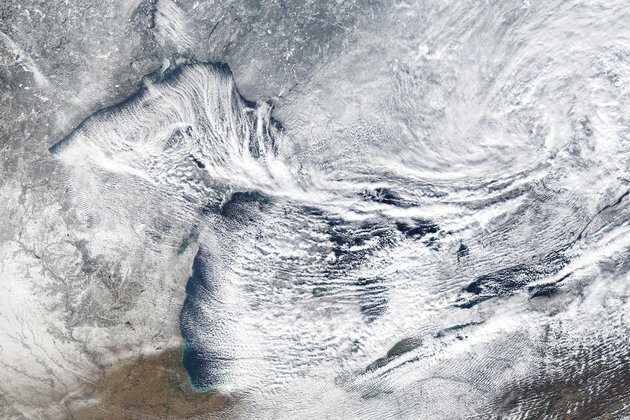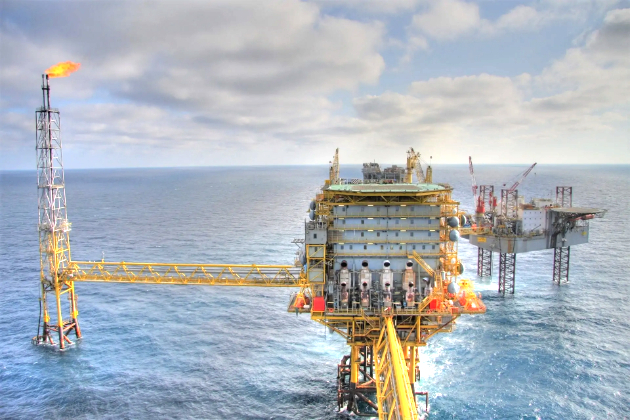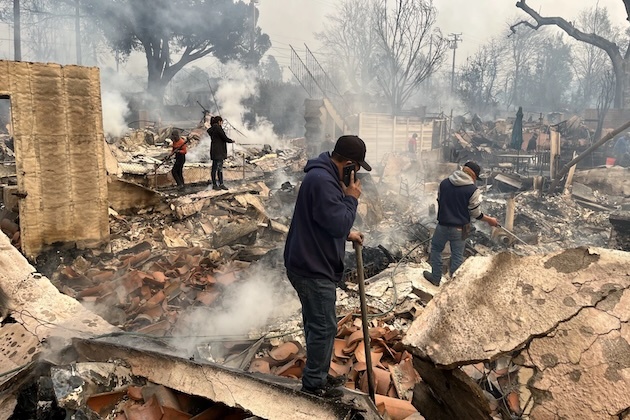What is lake-effect snow? A climate scientist explains
The Conversation
19 Nov 2022, 02:08 GMT+10

It's hard for most people to imagine more than 4 feet of snow in one storm, like the Buffalo area was forecast to see this weekend, but these extreme snowfall events happen periodically along the eastern edges of the Great Lakes.
The phenomenon is called "lake-effect snow," and the lakes themselves play a crucial role.
It starts with cold, dry air from Canada. As the bitter cold air sweeps across the relatively warmer Great Lakes, it sucks up more and more moisture that falls as snow.
I'm a climate scientist at UMass Amherst. In the Climate Dynamics course I teach, students often ask how cold, dry air can lead to heavy snowfall. Here's how that happens.
How dry air turns into snowstorms
Lake-effect snow is strongly influenced by the differences between the amount of heat and moisture at the lake surface and in the air a few thousand feet above it.
A big contrast creates conditions that help to suck water up from the lake, and thus more snowfall. A difference of 25 degrees Fahrenheit (14 C) or more creates an environment that can fuel heavy snows. This often happens in late fall, when lake water is still warm from summer and cold air starts sweeping down from Canada. More moderate lake-effect snows occur every fall under less extreme thermal contrasts.
Wind direction is important too. The farther cold air travels over the lake surface, the more moisture is evaporated from the lake. A long "fetch" - the distance over water - often results in more lake-effect snow than a shorter one.
Imagine a wind out of the west that is perfectly aligned so that it blows over the entire 241-mile length of Lake Erie. That's close to what Buffalo was experiencing the weekend of Nov. 18, 2022.
Once the snow reaches land, elevation contributes an additional effect. Land that slopes up from the lake increases lift in the atmosphere, enhancing snowfall rates. This mechanism is termed "orographic effect." The Tug Hill plateau, located between the lake and the Adirondacks in western New York, is well known for its impressive snowfall totals.
In a typical year, annual snowfall in the "lee," or downwind, of the Great Lakes approaches 200 inches in some places.
Residents in places like Buffalo are keenly aware of the phenomenon. In 2014, some parts of the region received upwards of 6 feet of snowfall during an epic lake-effect event Nov. 17-19. The weight of the snow collapsed hundreds of roofs and led to over a dozen deaths.
Lake-effect snowfall in the Buffalo area is typically confined to a narrow region where the wind is coming straight off the lake. Drivers on Interstate 90 often go from sunny skies to a blizzard and back to sunny skies over a distance of 30 to 40 miles.
The role of climate change
Is climate change playing a role in the lake-effect snow machine? To an extent.
Fall has warmed across the upper Midwest. Ice prevents lake water from evaporating into the overlying air, and it is forming later than in the past. Warmer summer air has led to warmer lake temperature into fall.
Models predict that with additional warming, more lake-effect snow will occur. But over time, the warming will lead to more of the precipitation falling as lake-effect rain, which already occurs in early fall, rather than snow.
Author: Michael A. Rawlins - Associate Director, Climate System Research Center, UMass Amherst 
 Share
Share
 Tweet
Tweet
 Share
Share
 Flip
Flip
 Email
Email
Watch latest videos
Subscribe and Follow
Get a daily dose of Massachusetts Sun news through our daily email, its complimentary and keeps you fully up to date with world and business news as well.
News RELEASES
Publish news of your business, community or sports group, personnel appointments, major event and more by submitting a news release to Massachusetts Sun.
More InformationInternational
SectionUS oil tariff may force foreign producers to pay $10 billion annually
WASHINGTON, D.C.: A proposed 10 percent U.S. tariff on oil imports could deal a US$10 billion annual blow to foreign producers, particularly...
Federal probe threatens $4 billion fund for California high-speed rail
LOS ANGELES, California: The Trump administration is once again challenging California's high-speed rail project, with federal transportation...
Republican Texas AG pushes stricter transgender policy in NCAA
LUBBOCK, Texas: The Republican attorney general of Texas, Ken Paxton, wants the NCAA to strengthen its transgender athlete policy by...
In defense of Californian lands, migrant workers dig in
When the Eaton Fire began on January 7, 2025, in Altadena, California, it blazed through residential neighborhoods, destroying thousands...
5 officers charged as police department in Alabama faces closure
HANCEVILLE, Alabama: A grand jury has recommended shutting down a small police department in Alabama due to widespread corruption after...
Mississippi judge tells newspaper to drop editorial criticizing mayor
CLARKSDALE, Mississippi: A judge in Mississippi has ordered a newspaper to take down an editorial that criticized the mayor and city...
Business
SectionNY Governor defends Manhattan congestion toll in meeting with Trump
NEW YORK CITY, New York: Governor Kathy Hochul met with President Donald Trump in the Oval Office to defend Manhattan's congestion...
Florida claims Target ‘misled investors’ with its DEI initiatives
TALLAHASSEE, Florida: Florida's new attorney general, James Uthmeier, filed a federal lawsuit against Target this week, claiming the...
Foxconn seeks Honda as a partner, eyes ties with Nissan, Mitsubishi
TOKYO, Japan: Foxconn has approached Honda Motor with a proposal to form a partnership, aiming to establish a broader collaboration...
Consumer Confidence Survey weighs on Wall Street
NEW YORK, New York - There was a mix of gains and losses in the United States on Tuesday with tech stocks selling off, and industrials...
Audi plans North America expansion with location expected this year
BERLIN, Germany: Audi is moving forward with plans to expand production in North America, and CEO Gernot Doellner said a decision on...
Reuters survey: Bank of Japan likely to hike rates to 0.75% in Q3
TOKYO, Japan: The Bank of Japan is expected to raise interest rates at least once more this year, likely in the third quarter, bringing...













